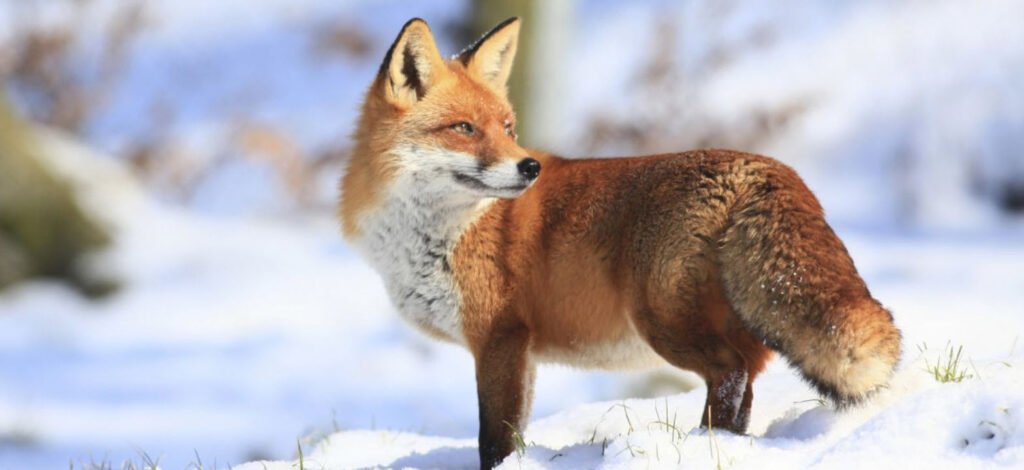
Foxes, belonging to the Canidae family, are a fascinating and diverse group of mammals found across the globe. Known for their intelligence, adaptability, and striking appearances, foxes have captured the interest and admiration of many.
Let’s explore into the marvelous world of foxes and explore 23 fantastic types that showcase the diversity within this charismatic family.
- Bengal Fox
- Blanford’s Fox
- Cape Fox
- Corsac Fox
- Tibetan Sand Fox
- Arctic Fox
- Kit Fox
- Pale Fox
- Ruppell’s Fox
- Swift Fox
- Red Fox
- Fennec Fox
- Gray Fox
- Island Fox
- Bat-Eared Fox
- Culpeo Fox
- Darwin’s Fox
- South American Gray Fox
- Pampas Fox
- Sechuran Fox
- Hoary Fox
- Crab-Eating Fox
- Simien Fox
1. Bengal Fox (Vulpes bengalensis)
The Bengal Fox, native to the Indian subcontinent, is a small and social fox species. Their reddish-brown fur and pointed ears are distinguishing features of this species.
2. Blanford’s Fox (Vulpes cana)
Blanford’s Fox, found in parts of the Middle East and South Asia, has a sandy coat and distinctive black markings on its face and ears.
3. Cape Fox (Vulpes chama)
Native to southern Africa, the Cape Fox is known for its grayish fur and black-tipped tail. They are primarily nocturnal and have keen hunting skills.
4. Corsac Fox (Vulpes corsac)
The Corsac Fox, found in Central Asia, has a distinct pale yellowish-grey fur and a bushy tail. They are skilled diggers and live in burrows.
5. Tibetan Sand Fox (Vulpes ferrilata)
Tibetan Sand Fox, residing in the high-altitude regions of Central Asia, has a distinctive sandy coat and bushy tail. They are well-adapted to their harsh mountainous habitat.
6. Arctic Fox (Vulpes lagopus)
The Arctic Fox, known for its thick white fur that turns gray in summer, is found in the Arctic regions. They are exceptional hunters and can withstand frigid temperatures.
7. Kit Fox (Vulpes macrotis)
The Kit Fox, residing in North America, is recognized for its small size and large ears. Their keen hearing aids in locating prey in the desert habitat they inhabit.
8. Pale Fox (Vulpes pallida)
The Pale Fox, native to the Sahel region of Africa, is named for its pale fur. Their nocturnal lifestyle helps them avoid the scorching heat of the day.
9. Ruppell’s Fox (Vulpes rueppellii)
Ruppell’s Fox, found in North Africa and the Middle East, has a sandy coat and prominent black markings. They are skilled hunters and opportunistic scavengers.
10. Swift Fox (Vulpes velox)
The Swift Fox, native to North America, is known for its speed and agility. They have a yellowish-gray coat and are primarily crepuscular hunters.
11. Red Fox (Vulpes vulpes)
The Red Fox, one of the most widespread and adaptable fox species, is known for its red or orange fur. They are highly intelligent and have a diverse diet.
12. Fennec Fox (Vulpes zerda)
The Fennec Fox, recognizable by its large ears, is native to the Sahara Desert. They have a creamy coat and are the smallest fox species.
13. Gray Fox (Urocyon cinereoargenteus)
The Gray Fox, found in North and Central America, is notable for its grizzled gray fur and ability to climb trees. They are omnivorous and adaptable.
14. Island Fox (Urocyon littoralis)
The Island Fox, endemic to the Channel Islands of California, comes in different subspecies. They are smaller in size and have adapted to island life.
15. Bat-Eared Fox (Otocyon megalotis)
The Bat-Eared Fox, native to Africa, is known for its large ears. They primarily feed on insects, making up a significant portion of their diet.
16. Culpeo Fox (Lycalopex culpaeus)
The Culpeo Fox, also known as the Andean Fox, is native to South America. They have a striking appearance with a bushy tail and reddish fur.
17. Darwin’s Fox (Lycalopex fulvipes)
Darwin’s Fox, endemic to Chile’s Nahuelbuta National Park, is critically endangered. Their reddish-brown fur and small size distinguish them.
18. South American Gray Fox (Lycalopex griseus)
The South American Gray Fox, native to South America, has a grayish coat and is highly adaptable to various habitats, from forests to grasslands.
19. Pampas Fox (Lycalopex gymnocercus)
The Pampas Fox, found in South America, has a short, grayish coat. They are opportunistic omnivores, feeding on a variety of food sources.
20. Sechuran Fox (Lycalopex sechurae)
The Sechuran Fox, native to Peru and Ecuador, has a unique golden-brown fur and distinctive facial markings. They primarily inhabit arid regions.
21. Hoary Fox (Lycalopex vetulus)
The Hoary Fox, endemic to Brazil, has a silvery-gray coat, giving it a ‘hoary’ appearance. They are solitary and primarily nocturnal.
22. Crab-Eating Fox (Cerdocyon thous)
The Crab-Eating Fox, native to South America, has a yellowish-gray coat and is named for its affinity for crabs. They are skilled climbers and swimmers.
23. Simien Fox (Canis simensis)
The Simien Fox, also known as the Ethiopian Wolf, is native to the Ethiopian Highlands. They have a distinctive red coat and are one of the rarest canids in the world.
Each of these 23 fantastic types of foxes showcases the remarkable diversity within the fox family. From the icy Arctic to the arid deserts, foxes have adapted and thrived in a multitude of habitats, leaving an indelible mark on the rich tapestry of the animal kingdom.
You may also like: